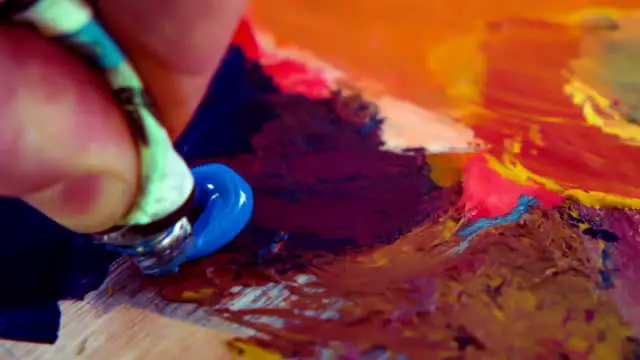The most simple distinction between acrylic and oil paints is that acrylics are water-based, whereas oils are — as the name implies — oil-based. Acrylic paints are called acrylics because an acrylic substance or mixture is used to combine the pigments and the water, since pigments and water do not combine well on their own. The pigments in acrylic paints also add other desirable qualities such as, thickness, vibrancy and preservation of color, and more.
Combining pigments with oils is not a problem and although paint manufactures have perfected the process in more recent times, simple techniques for doing so have been around for thousands of years. To make acrylic paints, a pigment, a binder, and a vehicle are required. Oil paints require only the pigments and the oil.
Both types of paint are used widely across disciplines, although the versatility of acrylic makes it a popular choice for home and industrial projects, and many artists, particularly more advanced painters, still prefer to use oil paints. There are many reasons one might prefer oils over acrylic or vice versa, and this article will help you better understand each medium.
The Pros and Cons of Working with Acrylic Paints
Acrylic paints were developed throughout the mid-20th century, beginning in 1934 when the BASF chemical company in Germany created the first usable acrylic dispersion formula. A decade later a mineral spirits acrylic paint was developed, attracting fine arts painters; however, it wasn’t until 1953 that acrylics resembling what we use today were developed by paint manufacturers simultaneously in Mexico and the US.
Though acrylic paint is incredibly versatile and can be customized for a wide variety of needs, even closely mimicking other paints like oils or watercolors, it isn’t perfect for all uses. Here are some benefits and drawbacks to acrylic paints.
The Advantages of Using Acrylic Paints
- Variety. There are so many varieties of acrylics. Today, you can choose from a whole spectrum of body, or thicknesses. There are full bodied acrylics, soft bodied, fluid, even acrylic inks.
- Customization. Likewise, there are countless mixing mediums on the market to use with your acrylic paints to customize their texture, handling, vibrancy, drying time, and preservation qualities.
- Drying time. Acrylic paints are known for drying quickly. I know speedy drying time isn’t universally desirable; depending on the project, your techniques and preferences, you may actually consider this a drawback. As mentioned above, there are mediums–such as gels and retarders–you can use to slow the drying process.
- Cost. It isn’t always true that acrylic paint is cheap — there are some specialized acrylic industrial and house paints that are extremely costly; however, generally speaking and in the fine arts sphere, acrylic paints are a much more affordable medium than oils.
- Adherence. Acrylic paint can readily be used with other mediums due to its ability to adhere to a wide variety of surfaces. A caveat to this is that when using acrylics and oils together, the acrylics must be applied first. I will explain this “fat-over-lean” rule in more detail in the last section.
- Convenience. There are no solvents required in the use of most acrylic paints. Keeping your brushes clean is quick and easy; just use lukewarm water. Soap is optional.
If you decide acrylic paint is right for you project, I highly recommend using Arteza Acrylic Paints. Amazon will frequently have amazing deals you can’t find anywhere else!
The Disadvantages of Using Acrylic Paints
- Quick drying. As mentioned above, this characteristic is both a benefit and a drawback of acrylics. Although there are mediums to increase the time they take to dry, it’s not quite the same as oils. For those accustomed to the lasting workability that comes with oil paints, acrylics dry too quickly and permanently. For industrial uses or when painting a room in your house, on the other hand, quicker is typically better.
- Appearance. There is a visual quality with oils that you can’t fully achieve with acrylics, though you can alter them to get pretty close. There is said to be a greater color variation visible in tinting and shading when using oils. I’ll explain more about why oils tend to look more vibrant below in the next section.
- Toxicity. During the drying process is when chemicals such as propylene glycol and ammonia release into the air and can be potentially harmful. Though acrylic paints are mostly safe to use, some varieties may be more toxic than others and adequate ventilation and disposal is always important.
The Pros and Cons of Working with Oil Paints
The use of oils as a binding agent for pigments is nothing new; oil paints have been used extensively throughout history. In fact, the first known example is a Buddhist mural that dates back to 650 AD. Pigments are most useful when dispersed in a medium that binds or “fixes”–and drying oils such as linseed, poppy, walnut, and safflower oils, were discovered early on to be the most effective. Linseed oil paint in particular rose to prominence in the 13th century, and linseed remains the most popular oil with which to manufacture paint today.
Most of those reading this will have had the experience of visiting a museum and seeing an oil painting created centuries ago, vibrant colors and textures still intact. Oil paints are truly time-tested. There have always been quirks and inherent struggles that come with painting in oils, however, and the development and continuous improvement of acrylic paints in recent times has certainly given oil paints some competition.
Let’s go over some of the benefits and drawbacks to working with oils.
The Advantages of Using Oil Paints
- Visual Quality. There is an unbeatable visual quality achieved with oil paints. This is likely due to the fact that a high ratio of pigment to oil can be used–thus most oil paints contain more physical color than acrylics or other paints. Current manufacturing techniques have eliminated imperfections in the mixing process, as well as the oil extraction process, further perfecting the appearance of oil paints. Therefore many of the flaws that have existed with oil paints over centuries, have been greatly minimized.
- Drying time. If you’re accustomed to working slowly, there is a real benefit to how slowly oil paints dry. It’s highly variable and dependent on technique, thickness, and environment, but the average drying time for oils is anywhere between several days to weeks. And by dry, I mean “sufficiently dry”–enough to continue working. Oils do not dry in the same way water-based paints dry–water content evaporating into the atmosphere; instead, the exposure of the oils to the air eventually causes them to harden and lock. This extra time allows for frequent reworking, something artists familiar with the medium come to rely on.
- Tradition. Fine art painters tend to enjoy the tradition of oil paints, and many continue to mix their own–despite advancements in commercial manufacturing–combining pigments and oils according to their own unique preferences.
Winsor & Newton have a professional oil set with 10 colors that’s worth checking out here.
The Disadvantages of Using Oil Paints
- Drying time. The most common complaint about the use of oil paints is likely coming from someone just starting out in the medium, but it’s a valid complaint nonetheless. Until you’ve gotten comfortable with your technique, reworking or adding sections slowly over time, the pace at which it dries can feel inhibiting and even stifle your creative flow. It takes practice and patience; however, solvents such as turpentine, among others, have been known to help speed things along.
- Toxicity of solvents and mediums. Oil paints on their own will not release toxins into the air during the drying process, but the mediums and solvents commonly used with oils, such as turpentine, will. Proper ventilation is always a good practice.
When to Use Oils vs. Acrylics
Knowing more about both types of paint should help you decide which one is best for your project. As someone with experience using both, I can provide you with some simple examples of when I might choose one or the other.
Painting on fabric. Printmakers often use acrylic inks in their practice and this once gave me the idea to linoleum-block print some t-shirt using the acrylic paint I had lying around. They turned out great!
Acrylic paint is a great choice for fabrics because their flexibility means they are less likely to crack with so much movement. Though you could prime the fabric, it’s not necessary. Oils on fabric would require sufficient priming, otherwise they’d seep through and you’d end up with a mess.
Painting a composition. If I planned on creating a landscape or portrait on stretched canvas or a wood panel, I would almost always choose oil paints. The convenience of acrylics, to me, is what makes them so tempting; however, there is a richness to the color and texture with oils that I haven’t seen matched with acrylics.
Many artists have composed underpainting with acrylics, only adding touches in oils on top. There are creative reasons for doing this I am sure, but given the price of oils and the price of acrylics, this could be a money saver for those who want to retain that richness and vibrancy of oil paints on a budget. The “fat-over-lean” rule is a reminder to always apply the thicker, slower drying mediums on top of the quick drying mediums. This ensures that your surface isn’t solidifying only to crack over time as the underlayer continues to dry and contract. So using oils and acrylics together is a great idea, as long as you apply them in the right order!
Home decor. Oil paints are rarely used for large scale projects anymore such as interior or exterior house painting. Acrylics are so advanced now, that the versatility, durability, and customization often outweigh what oils have to offer in this context. Whether for painting the walls, or adding stencils or decorative murals, I’d choose acrylic paints in this scenario.

